Report on Generational Diversity Management Challenges at Westpac
VerifiedAdded on 2024/07/02
|15
|2848
|289
Report
AI Summary
This business report analyzes the challenges faced by Westpac in managing generational diversity, stemming from differing values, communication styles, and work ethics across five generations (Traditionalists, Baby Boomers, Generation X, Millennials, and Generation Z). It identifies key issues like cultural expectations, communication problems, and negative stereotypes, which can lead to workplace conflicts and reduced productivity. The report suggests solutions such as creating mixed-generation project teams, fostering open communication, conducting generational awareness sessions, offering workplace choices to accommodate differences, and implementing mentoring programs. By addressing these challenges and promoting understanding, Westpac can leverage the unique perspectives and skills of each generation, leading to a more unified and efficient organization. Desklib provides students access to similar solved assignments and resources.

Business Report
Student name:
Student ID:
1
Student name:
Student ID:
1
Paraphrase This Document
Need a fresh take? Get an instant paraphrase of this document with our AI Paraphraser
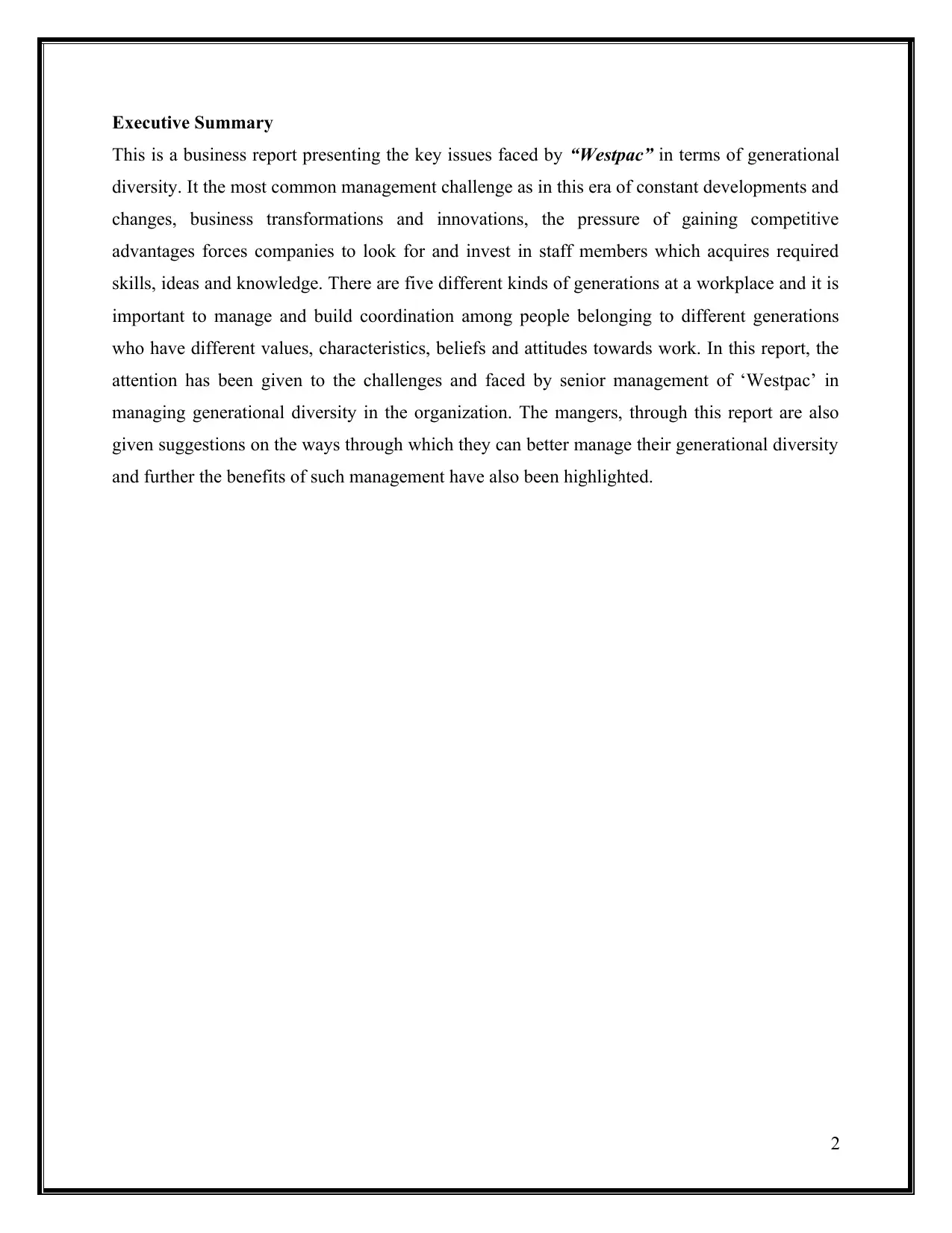
Executive Summary
This is a business report presenting the key issues faced by “Westpac” in terms of generational
diversity. It the most common management challenge as in this era of constant developments and
changes, business transformations and innovations, the pressure of gaining competitive
advantages forces companies to look for and invest in staff members which acquires required
skills, ideas and knowledge. There are five different kinds of generations at a workplace and it is
important to manage and build coordination among people belonging to different generations
who have different values, characteristics, beliefs and attitudes towards work. In this report, the
attention has been given to the challenges and faced by senior management of ‘Westpac’ in
managing generational diversity in the organization. The mangers, through this report are also
given suggestions on the ways through which they can better manage their generational diversity
and further the benefits of such management have also been highlighted.
2
This is a business report presenting the key issues faced by “Westpac” in terms of generational
diversity. It the most common management challenge as in this era of constant developments and
changes, business transformations and innovations, the pressure of gaining competitive
advantages forces companies to look for and invest in staff members which acquires required
skills, ideas and knowledge. There are five different kinds of generations at a workplace and it is
important to manage and build coordination among people belonging to different generations
who have different values, characteristics, beliefs and attitudes towards work. In this report, the
attention has been given to the challenges and faced by senior management of ‘Westpac’ in
managing generational diversity in the organization. The mangers, through this report are also
given suggestions on the ways through which they can better manage their generational diversity
and further the benefits of such management have also been highlighted.
2
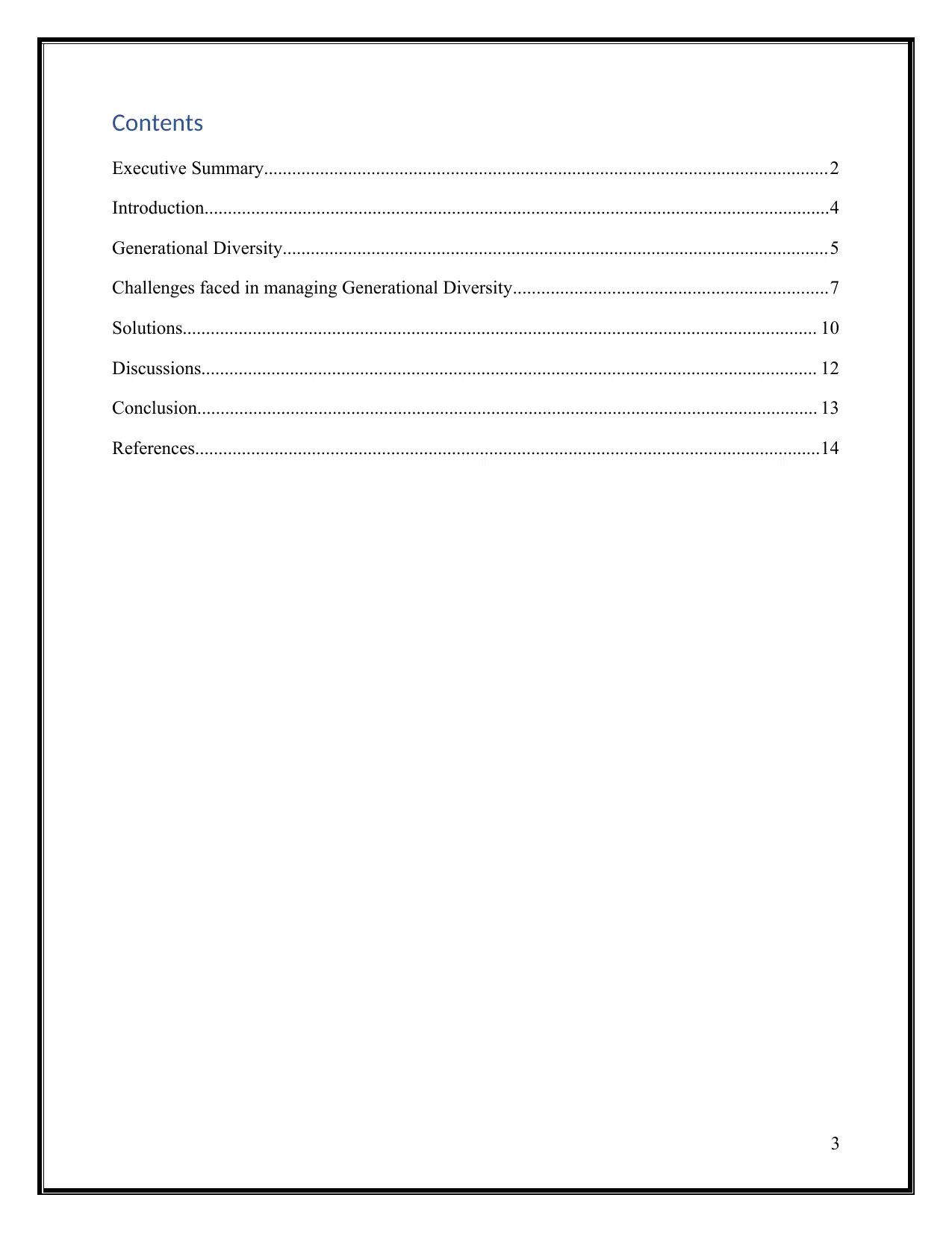
Contents
Executive Summary.........................................................................................................................2
Introduction......................................................................................................................................4
Generational Diversity.....................................................................................................................5
Challenges faced in managing Generational Diversity...................................................................7
Solutions........................................................................................................................................ 10
Discussions.................................................................................................................................... 12
Conclusion..................................................................................................................................... 13
References......................................................................................................................................14
3
Executive Summary.........................................................................................................................2
Introduction......................................................................................................................................4
Generational Diversity.....................................................................................................................5
Challenges faced in managing Generational Diversity...................................................................7
Solutions........................................................................................................................................ 10
Discussions.................................................................................................................................... 12
Conclusion..................................................................................................................................... 13
References......................................................................................................................................14
3
⊘ This is a preview!⊘
Do you want full access?
Subscribe today to unlock all pages.

Trusted by 1+ million students worldwide
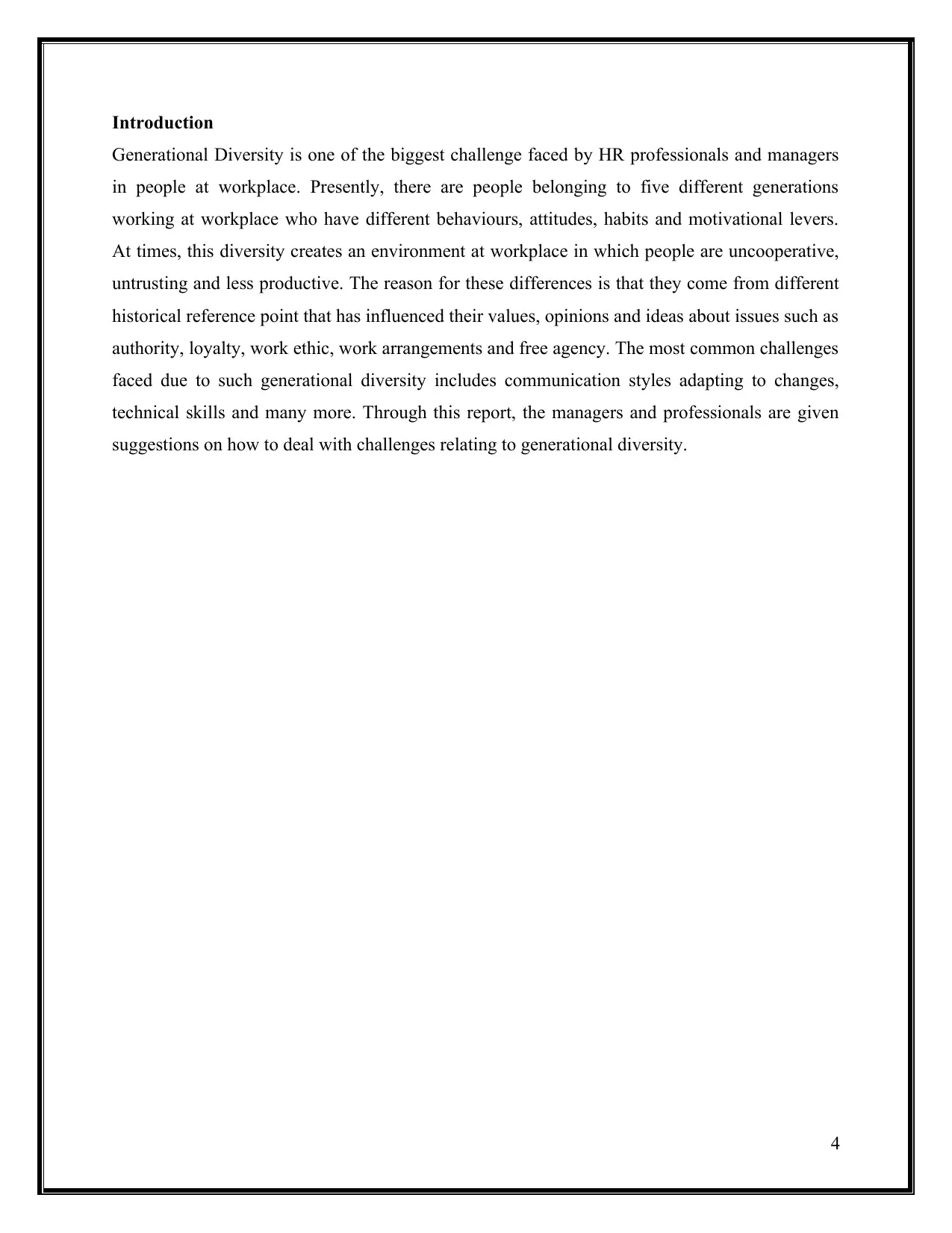
Introduction
Generational Diversity is one of the biggest challenge faced by HR professionals and managers
in people at workplace. Presently, there are people belonging to five different generations
working at workplace who have different behaviours, attitudes, habits and motivational levers.
At times, this diversity creates an environment at workplace in which people are uncooperative,
untrusting and less productive. The reason for these differences is that they come from different
historical reference point that has influenced their values, opinions and ideas about issues such as
authority, loyalty, work ethic, work arrangements and free agency. The most common challenges
faced due to such generational diversity includes communication styles adapting to changes,
technical skills and many more. Through this report, the managers and professionals are given
suggestions on how to deal with challenges relating to generational diversity.
4
Generational Diversity is one of the biggest challenge faced by HR professionals and managers
in people at workplace. Presently, there are people belonging to five different generations
working at workplace who have different behaviours, attitudes, habits and motivational levers.
At times, this diversity creates an environment at workplace in which people are uncooperative,
untrusting and less productive. The reason for these differences is that they come from different
historical reference point that has influenced their values, opinions and ideas about issues such as
authority, loyalty, work ethic, work arrangements and free agency. The most common challenges
faced due to such generational diversity includes communication styles adapting to changes,
technical skills and many more. Through this report, the managers and professionals are given
suggestions on how to deal with challenges relating to generational diversity.
4
Paraphrase This Document
Need a fresh take? Get an instant paraphrase of this document with our AI Paraphraser
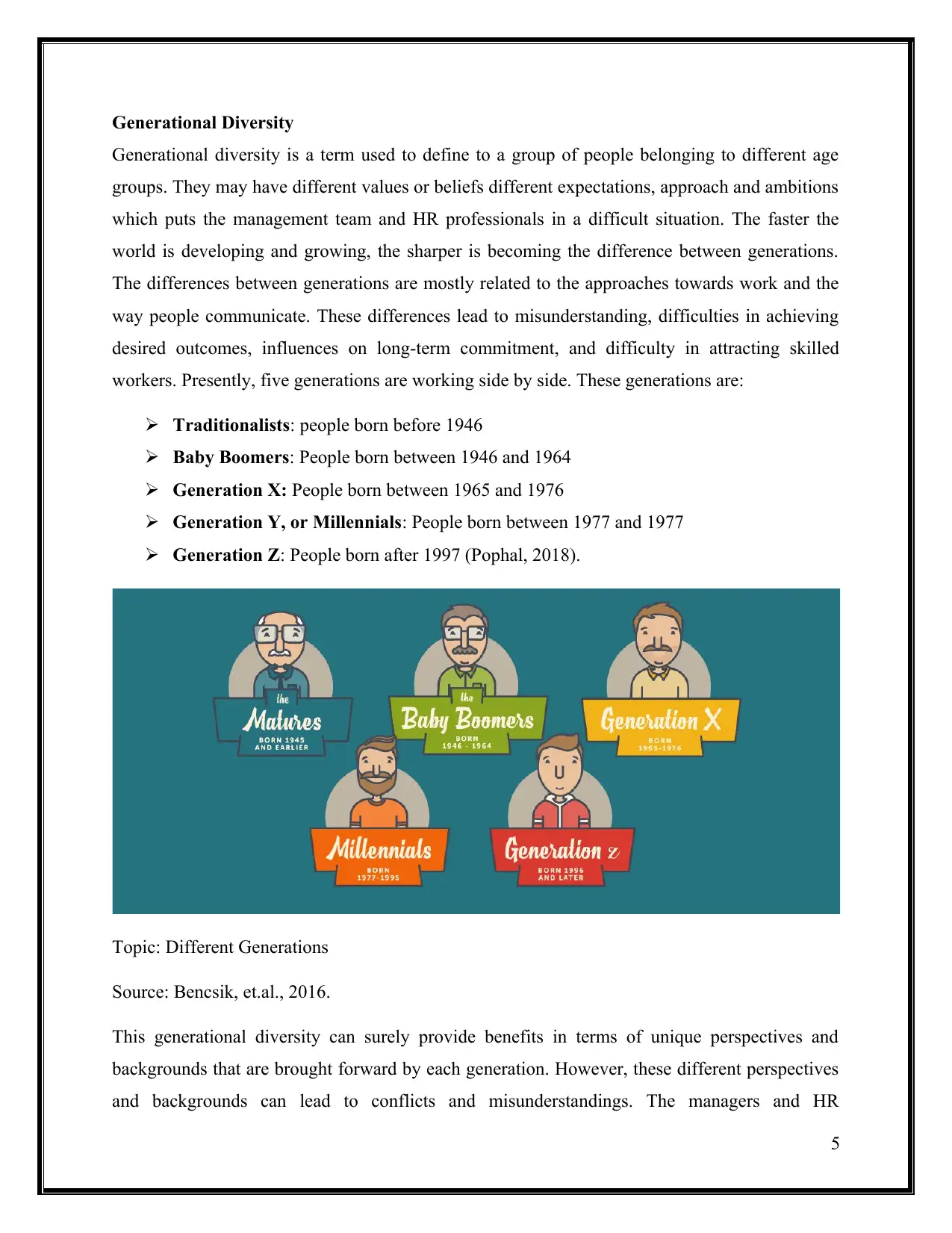
Generational Diversity
Generational diversity is a term used to define to a group of people belonging to different age
groups. They may have different values or beliefs different expectations, approach and ambitions
which puts the management team and HR professionals in a difficult situation. The faster the
world is developing and growing, the sharper is becoming the difference between generations.
The differences between generations are mostly related to the approaches towards work and the
way people communicate. These differences lead to misunderstanding, difficulties in achieving
desired outcomes, influences on long-term commitment, and difficulty in attracting skilled
workers. Presently, five generations are working side by side. These generations are:
Traditionalists: people born before 1946
Baby Boomers: People born between 1946 and 1964
Generation X: People born between 1965 and 1976
Generation Y, or Millennials: People born between 1977 and 1977
Generation Z: People born after 1997 (Pophal, 2018).
Topic: Different Generations
Source: Bencsik, et.al., 2016.
This generational diversity can surely provide benefits in terms of unique perspectives and
backgrounds that are brought forward by each generation. However, these different perspectives
and backgrounds can lead to conflicts and misunderstandings. The managers and HR
5
Generational diversity is a term used to define to a group of people belonging to different age
groups. They may have different values or beliefs different expectations, approach and ambitions
which puts the management team and HR professionals in a difficult situation. The faster the
world is developing and growing, the sharper is becoming the difference between generations.
The differences between generations are mostly related to the approaches towards work and the
way people communicate. These differences lead to misunderstanding, difficulties in achieving
desired outcomes, influences on long-term commitment, and difficulty in attracting skilled
workers. Presently, five generations are working side by side. These generations are:
Traditionalists: people born before 1946
Baby Boomers: People born between 1946 and 1964
Generation X: People born between 1965 and 1976
Generation Y, or Millennials: People born between 1977 and 1977
Generation Z: People born after 1997 (Pophal, 2018).
Topic: Different Generations
Source: Bencsik, et.al., 2016.
This generational diversity can surely provide benefits in terms of unique perspectives and
backgrounds that are brought forward by each generation. However, these different perspectives
and backgrounds can lead to conflicts and misunderstandings. The managers and HR
5
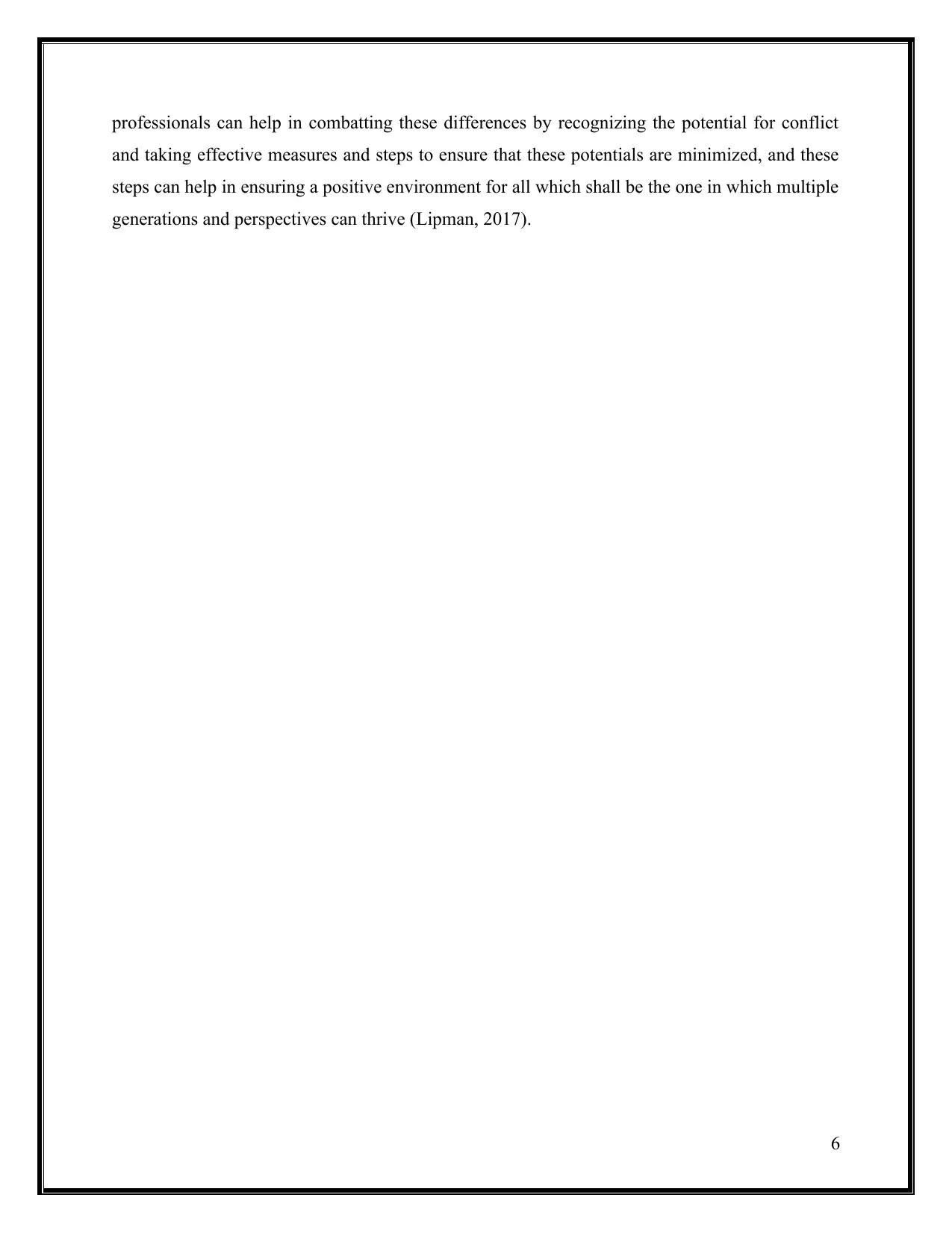
professionals can help in combatting these differences by recognizing the potential for conflict
and taking effective measures and steps to ensure that these potentials are minimized, and these
steps can help in ensuring a positive environment for all which shall be the one in which multiple
generations and perspectives can thrive (Lipman, 2017).
6
and taking effective measures and steps to ensure that these potentials are minimized, and these
steps can help in ensuring a positive environment for all which shall be the one in which multiple
generations and perspectives can thrive (Lipman, 2017).
6
⊘ This is a preview!⊘
Do you want full access?
Subscribe today to unlock all pages.

Trusted by 1+ million students worldwide

Challenges faced in managing Generational Diversity
Generational diversity can contribute to the conflicts at workplace. It is a growing phenomenon
in contemporary business environment. These conflicts arise mostly out of difference in
attitudes, behaviour, experiences, principles and other traits among the different generations. The
issues of these conflicts are required to be identified to design motivation systems, reward and
compensation programs, and can also help the managers in recognizing appropriate techniques to
manage their subordinates (Costanza, and Finkelstein, 2015). The most common issues that have
been noticed in ‘Westpac’ includes the following:
Cultural Expectations: It is the most common problem faced by mangers when
managing people belonging to different generations. To keep up with the technological
advances and changing trends, the culture of the company keeps changing constantly.
This also results in consequential shift in cultural expectations. In particular, this is a
jarring transition for people belonging to older generations, who are used to measuring
the performance by spending number of hours on their desk. However, for the young
people and managers, time spent on the desk in office is not as important as the produced
results. The focus of young generation is only on the results rather than the work ethics
solely. The work ethic of being an early bird in office may not be very impressive for the
young generations whereas the older generations believe that punctuality is the key for
completion of tasks effectively. The members of Generation Y believes and expects value
and a work-life balance (Burkman, 2016).
Further, significant divide has been noticed between how the people belonging to
different generations prefer to work. This divide is not limited to time and punctuality.
Baby boomers prefers putting long workday at their offices, Generation Y and Z people
prefers working through telecommuting options and in flexible hours. However, the
young workers prefer working based on groups and daily feedbacks.
Communication Problems: The preferred communication styles of different
generations are based on the technologies and options available in their times. Such
difference in communication style preferences has become a cliché. The people
belonging to Generation Y and Z prefers sending text messages, instant messages or
tweets to communicate. However, old generation people or people belonging to
Generation X and baby boomers prefers communicating through E-mails and phone calls.
7
Generational diversity can contribute to the conflicts at workplace. It is a growing phenomenon
in contemporary business environment. These conflicts arise mostly out of difference in
attitudes, behaviour, experiences, principles and other traits among the different generations. The
issues of these conflicts are required to be identified to design motivation systems, reward and
compensation programs, and can also help the managers in recognizing appropriate techniques to
manage their subordinates (Costanza, and Finkelstein, 2015). The most common issues that have
been noticed in ‘Westpac’ includes the following:
Cultural Expectations: It is the most common problem faced by mangers when
managing people belonging to different generations. To keep up with the technological
advances and changing trends, the culture of the company keeps changing constantly.
This also results in consequential shift in cultural expectations. In particular, this is a
jarring transition for people belonging to older generations, who are used to measuring
the performance by spending number of hours on their desk. However, for the young
people and managers, time spent on the desk in office is not as important as the produced
results. The focus of young generation is only on the results rather than the work ethics
solely. The work ethic of being an early bird in office may not be very impressive for the
young generations whereas the older generations believe that punctuality is the key for
completion of tasks effectively. The members of Generation Y believes and expects value
and a work-life balance (Burkman, 2016).
Further, significant divide has been noticed between how the people belonging to
different generations prefer to work. This divide is not limited to time and punctuality.
Baby boomers prefers putting long workday at their offices, Generation Y and Z people
prefers working through telecommuting options and in flexible hours. However, the
young workers prefer working based on groups and daily feedbacks.
Communication Problems: The preferred communication styles of different
generations are based on the technologies and options available in their times. Such
difference in communication style preferences has become a cliché. The people
belonging to Generation Y and Z prefers sending text messages, instant messages or
tweets to communicate. However, old generation people or people belonging to
Generation X and baby boomers prefers communicating through E-mails and phone calls.
7
Paraphrase This Document
Need a fresh take? Get an instant paraphrase of this document with our AI Paraphraser
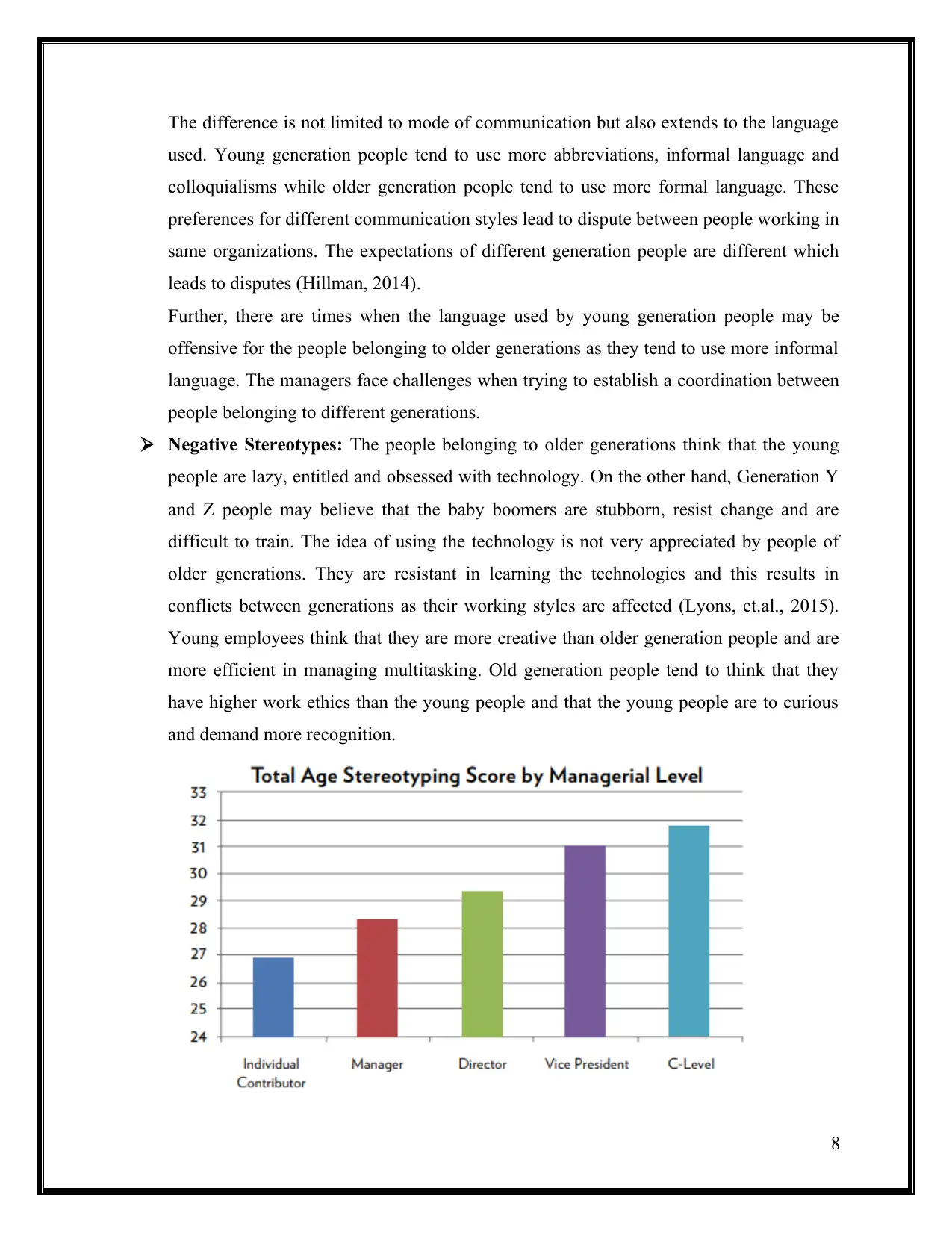
The difference is not limited to mode of communication but also extends to the language
used. Young generation people tend to use more abbreviations, informal language and
colloquialisms while older generation people tend to use more formal language. These
preferences for different communication styles lead to dispute between people working in
same organizations. The expectations of different generation people are different which
leads to disputes (Hillman, 2014).
Further, there are times when the language used by young generation people may be
offensive for the people belonging to older generations as they tend to use more informal
language. The managers face challenges when trying to establish a coordination between
people belonging to different generations.
Negative Stereotypes: The people belonging to older generations think that the young
people are lazy, entitled and obsessed with technology. On the other hand, Generation Y
and Z people may believe that the baby boomers are stubborn, resist change and are
difficult to train. The idea of using the technology is not very appreciated by people of
older generations. They are resistant in learning the technologies and this results in
conflicts between generations as their working styles are affected (Lyons, et.al., 2015).
Young employees think that they are more creative than older generation people and are
more efficient in managing multitasking. Old generation people tend to think that they
have higher work ethics than the young people and that the young people are to curious
and demand more recognition.
8
used. Young generation people tend to use more abbreviations, informal language and
colloquialisms while older generation people tend to use more formal language. These
preferences for different communication styles lead to dispute between people working in
same organizations. The expectations of different generation people are different which
leads to disputes (Hillman, 2014).
Further, there are times when the language used by young generation people may be
offensive for the people belonging to older generations as they tend to use more informal
language. The managers face challenges when trying to establish a coordination between
people belonging to different generations.
Negative Stereotypes: The people belonging to older generations think that the young
people are lazy, entitled and obsessed with technology. On the other hand, Generation Y
and Z people may believe that the baby boomers are stubborn, resist change and are
difficult to train. The idea of using the technology is not very appreciated by people of
older generations. They are resistant in learning the technologies and this results in
conflicts between generations as their working styles are affected (Lyons, et.al., 2015).
Young employees think that they are more creative than older generation people and are
more efficient in managing multitasking. Old generation people tend to think that they
have higher work ethics than the young people and that the young people are to curious
and demand more recognition.
8
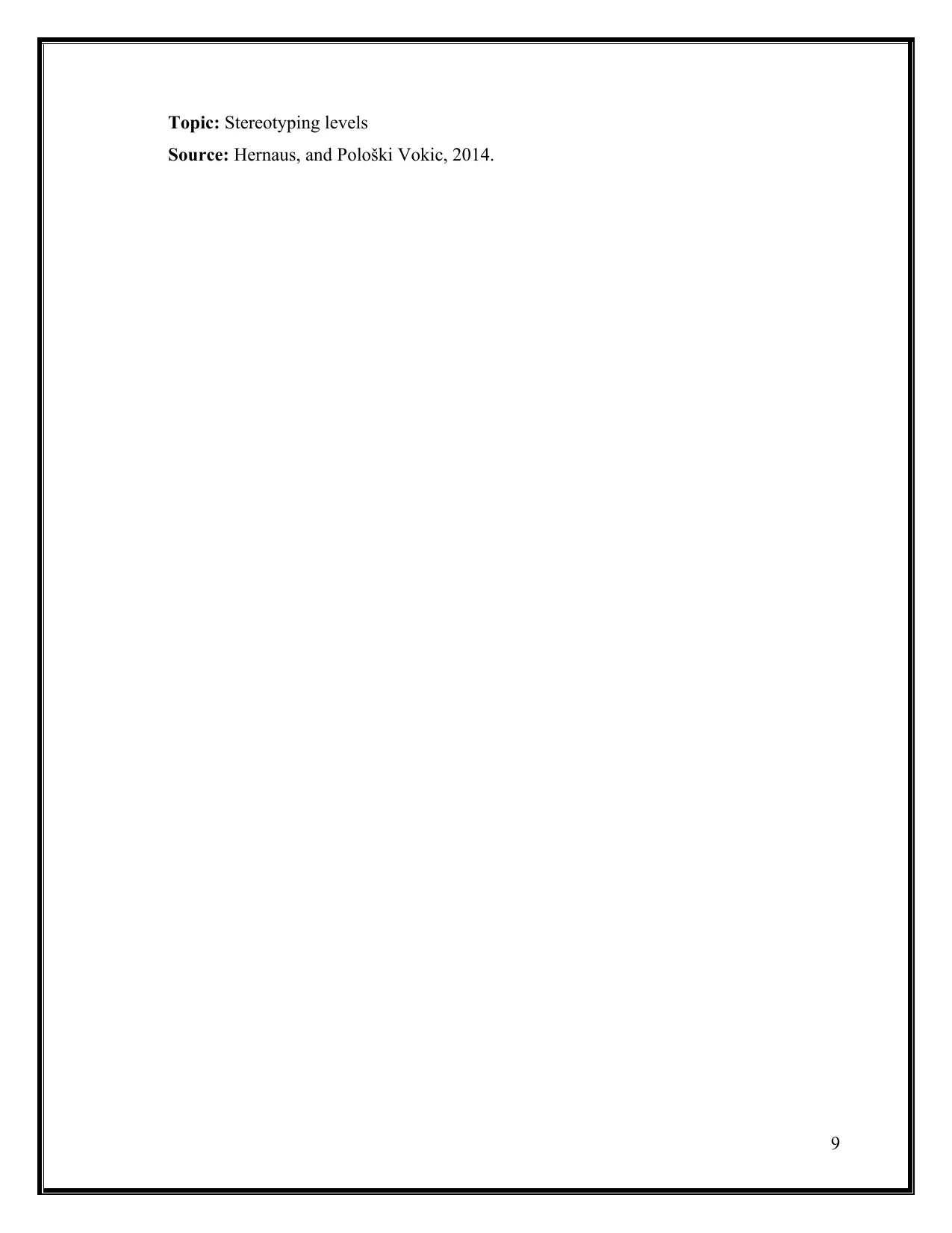
Topic: Stereotyping levels
Source: Hernaus, and Pološki Vokic, 2014.
9
Source: Hernaus, and Pološki Vokic, 2014.
9
⊘ This is a preview!⊘
Do you want full access?
Subscribe today to unlock all pages.

Trusted by 1+ million students worldwide

Solutions
The generational diversity impacts the efficiency and productivity of ‘Westpac’ to a great extent.
It is a growing phenomenon in the contemporary business environment. Presently, largest
diversity is presented in organization as the people working belong to five different generations.
Their work ethics, values, communication styles, expectations and many other aspects are
different from each other which lead to conflicts between them. It is important for the mangers
and leaders to recognize that the age and background of employees often impact their approach
towards work. However, if these generations work together by giving up their generational gaps,
the efficiency of organization shall become unbeatable. Therefore, these conflicts must be
resolved, and following approaches can be used to resolve such issues:
Mix and match project teams: The managers can use team building as an opportunity o
minimize the generational diversity at workplace. The managers may build the teams by
mixing people from different generations and helping them in communicating with each
other to come up with effective and efficient results. When a team comprises of people
belonging to different generations, then the team shall be able to take advantage of
diverse perspectives and complementary skills (Amayah, and Gedro, 2014).
Open Communication: The managers must ensure that the team members are open to
each other at that they respect each other’s preferred mode of communication.
Recognizing these differences in modes of communication and cooperating with each
other can minimize the misunderstandings. The companies must also recognize the issue
of generational communication differences and it must build and enforce multiple
channels for communication with and among employees so that the message reaches the
intended receiver.
Talk about generational differences: As per American Management Association, an
organization and its managers must conduct sharing sessions and generational
information awareness to get the people across various generations work together. These
sessions provide opportunities and are very effective to educate each other about the
history, culture, characteristics, preferences and such other aspects of each generation
(Roberts, et.al., 2012).
Create workplace choices and accommodate differences: The managers must allow
the culture in organization and the workplace shape itself around the people, work being
10
The generational diversity impacts the efficiency and productivity of ‘Westpac’ to a great extent.
It is a growing phenomenon in the contemporary business environment. Presently, largest
diversity is presented in organization as the people working belong to five different generations.
Their work ethics, values, communication styles, expectations and many other aspects are
different from each other which lead to conflicts between them. It is important for the mangers
and leaders to recognize that the age and background of employees often impact their approach
towards work. However, if these generations work together by giving up their generational gaps,
the efficiency of organization shall become unbeatable. Therefore, these conflicts must be
resolved, and following approaches can be used to resolve such issues:
Mix and match project teams: The managers can use team building as an opportunity o
minimize the generational diversity at workplace. The managers may build the teams by
mixing people from different generations and helping them in communicating with each
other to come up with effective and efficient results. When a team comprises of people
belonging to different generations, then the team shall be able to take advantage of
diverse perspectives and complementary skills (Amayah, and Gedro, 2014).
Open Communication: The managers must ensure that the team members are open to
each other at that they respect each other’s preferred mode of communication.
Recognizing these differences in modes of communication and cooperating with each
other can minimize the misunderstandings. The companies must also recognize the issue
of generational communication differences and it must build and enforce multiple
channels for communication with and among employees so that the message reaches the
intended receiver.
Talk about generational differences: As per American Management Association, an
organization and its managers must conduct sharing sessions and generational
information awareness to get the people across various generations work together. These
sessions provide opportunities and are very effective to educate each other about the
history, culture, characteristics, preferences and such other aspects of each generation
(Roberts, et.al., 2012).
Create workplace choices and accommodate differences: The managers must allow
the culture in organization and the workplace shape itself around the people, work being
10
Paraphrase This Document
Need a fresh take? Get an instant paraphrase of this document with our AI Paraphraser

done, and the customers being served. Provide the employees with flexibility in working
and taking their decisions. The employees must be treated as customers and the managers
and people at conflict must have a word with each other as and when the conflict arises.
Offer mentoring programs: The employees belonging to different generations can be
provided training on mentoring ensuring that the critical job knowledge and skill sets are
shared among employees, particularly from one generation to another. These training
programs can work both ways. The older generation can share knowledge gained form
years of experience and the young ones can help the older generation in learning
technical and computer skills. Various methods of mentoring can be group programs,
one-to-one sessions, and such others (Marcinkus Murphy, 2012).
Topic: The Generational Diversity Management Implementation Process
Source: Statnickė, 2016.
11
and taking their decisions. The employees must be treated as customers and the managers
and people at conflict must have a word with each other as and when the conflict arises.
Offer mentoring programs: The employees belonging to different generations can be
provided training on mentoring ensuring that the critical job knowledge and skill sets are
shared among employees, particularly from one generation to another. These training
programs can work both ways. The older generation can share knowledge gained form
years of experience and the young ones can help the older generation in learning
technical and computer skills. Various methods of mentoring can be group programs,
one-to-one sessions, and such others (Marcinkus Murphy, 2012).
Topic: The Generational Diversity Management Implementation Process
Source: Statnickė, 2016.
11
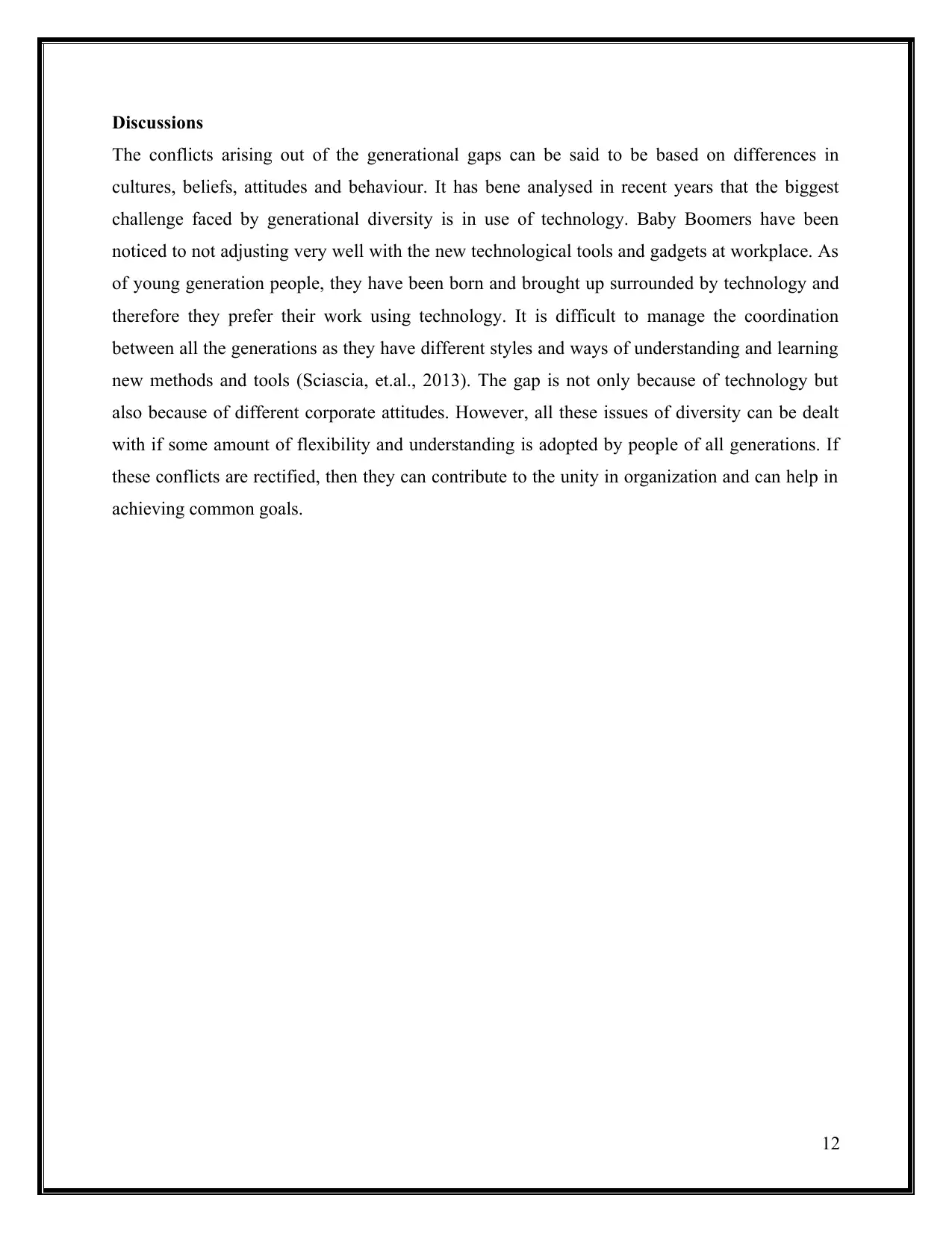
Discussions
The conflicts arising out of the generational gaps can be said to be based on differences in
cultures, beliefs, attitudes and behaviour. It has bene analysed in recent years that the biggest
challenge faced by generational diversity is in use of technology. Baby Boomers have been
noticed to not adjusting very well with the new technological tools and gadgets at workplace. As
of young generation people, they have been born and brought up surrounded by technology and
therefore they prefer their work using technology. It is difficult to manage the coordination
between all the generations as they have different styles and ways of understanding and learning
new methods and tools (Sciascia, et.al., 2013). The gap is not only because of technology but
also because of different corporate attitudes. However, all these issues of diversity can be dealt
with if some amount of flexibility and understanding is adopted by people of all generations. If
these conflicts are rectified, then they can contribute to the unity in organization and can help in
achieving common goals.
12
The conflicts arising out of the generational gaps can be said to be based on differences in
cultures, beliefs, attitudes and behaviour. It has bene analysed in recent years that the biggest
challenge faced by generational diversity is in use of technology. Baby Boomers have been
noticed to not adjusting very well with the new technological tools and gadgets at workplace. As
of young generation people, they have been born and brought up surrounded by technology and
therefore they prefer their work using technology. It is difficult to manage the coordination
between all the generations as they have different styles and ways of understanding and learning
new methods and tools (Sciascia, et.al., 2013). The gap is not only because of technology but
also because of different corporate attitudes. However, all these issues of diversity can be dealt
with if some amount of flexibility and understanding is adopted by people of all generations. If
these conflicts are rectified, then they can contribute to the unity in organization and can help in
achieving common goals.
12
⊘ This is a preview!⊘
Do you want full access?
Subscribe today to unlock all pages.

Trusted by 1+ million students worldwide
1 out of 15
Related Documents
Your All-in-One AI-Powered Toolkit for Academic Success.
+13062052269
info@desklib.com
Available 24*7 on WhatsApp / Email
![[object Object]](/_next/static/media/star-bottom.7253800d.svg)
Unlock your academic potential
Copyright © 2020–2025 A2Z Services. All Rights Reserved. Developed and managed by ZUCOL.





